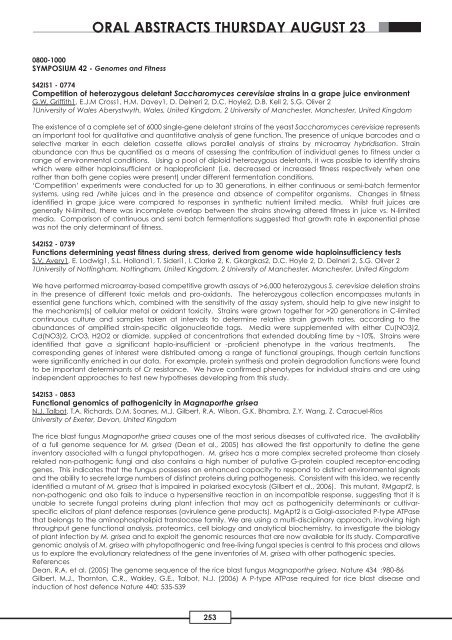Handbook Part 2 - International Mycological Association
Handbook Part 2 - International Mycological Association
Handbook Part 2 - International Mycological Association
Create successful ePaper yourself
Turn your PDF publications into a flip-book with our unique Google optimized e-Paper software.
ORAL ABSTRACTS THURSDAY AUGUST 23<br />
0800-1000<br />
SYMPOSIUM 42 - Genomes and Fitness<br />
S42IS1 - 0774<br />
Competition of heterozygous deletant Saccharomyces cerevisiae strains in a grape juice environment<br />
G.W. Griffith1, E.J.M Cross1, H.M. Davey1, D. Delneri 2, D.C. Hoyle2, D.B. Kell 2, S.G. Oliver 2<br />
1University of Wales Aberystwyth, Wales, United Kingdom, 2 University of Manchester, Manchester, United Kingdom<br />
The existence of a complete set of 6000 single-gene deletant strains of the yeast Saccharomyces cerevisiae represents<br />
an important tool for qualitative and quantitative analysis of gene function. The presence of unique barcodes and a<br />
selective marker in each deletion cassette allows parallel analysis of strains by microarray hybridisation. Strain<br />
abundance can thus be quantified as a means of assessing the contribution of individual genes to fitness under a<br />
range of environmental conditions. Using a pool of diploid heterozygous deletants, it was possible to identify strains<br />
which were either haploinsufficient or haploproficient (i.e. decreased or increased fitness respectively when one<br />
rather than both gene copies were present) under different fermentation conditions.<br />
‘Competition’ experiments were conducted for up to 30 generations, in either continuous or semi-batch fermentor<br />
systems, using red /white juices and in the presence and absence of competitor organisms. Changes in fitness<br />
identified in grape juice were compared to responses in synthetic nutrient limited media. Whilst fruit juices are<br />
generally N-limited, there was incomplete overlap between the strains showing altered fitness in juice vs. N-limited<br />
media. Comparison of continuous and semi batch fermentations suggested that growth rate in exponential phase<br />
was not the only determinant of fitness.<br />
S42IS2 - 0739<br />
Functions determining yeast fitness during stress, derived from genome wide haploinsufficiency tests<br />
S.V. Avery1, E. Lodwig1, S.L. Holland1, T. Sideri1, I. Clarke 2, K. Gkargkas2, D.C. Hoyle 2, D. Delneri 2, S.G. Oliver 2<br />
1University of Nottingham, Nottingham, United Kingdom, 2 University of Manchester, Manchester, United Kingdom<br />
We have performed microarray-based competitive growth assays of >6,000 heterozygous S. cerevisiae deletion strains<br />
in the presence of different toxic metals and pro-oxidants. The heterozygous collection encompasses mutants in<br />
essential gene functions which, combined with the sensitivity of the assay system, should help to give new insight to<br />
the mechanism(s) of cellular metal or oxidant toxicity. Strains were grown together for >20 generations in C-limited<br />
continuous culture and samples taken at intervals to determine relative strain growth rates, according to the<br />
abundances of amplified strain-specific oligonucleotide tags. Media were supplemented with either Cu(NO3)2,<br />
Cd(NO3)2, CrO3, H2O2 or diamide, supplied at concentrations that extended doubling time by ~10%. Strains were<br />
identified that gave a significant haplo-insufficient or -proficient phenotype in the various treatments. The<br />
corresponding genes of interest were distributed among a range of functional groupings, though certain functions<br />
were significantly enriched in our data. For example, protein synthesis and protein degradation functions were found<br />
to be important determinants of Cr resistance. We have confirmed phenotypes for individual strains and are using<br />
independent approaches to test new hypotheses developing from this study.<br />
S42IS3 - 0853<br />
Functional genomics of pathogenicity in Magnaporthe grisea<br />
N.J. Talbot, T.A. Richards, D.M. Soanes, M.J. Gilbert, R.A. Wilson, G.K. Bhambra, Z.Y. Wang, Z. Caracuel-Rios<br />
University of Exeter, Devon, United Kingdom<br />
The rice blast fungus Magnaporthe grisea causes one of the most serious diseases of cultivated rice. The availability<br />
of a full genome sequence for M. grisea (Dean et al., 2005) has allowed the first opportunity to define the gene<br />
inventory associated with a fungal phytopathogen. M. grisea has a more complex secreted proteome than closely<br />
related non-pathogenic fungi and also contains a high number of putative G-protein coupled receptor-encoding<br />
genes. This indicates that the fungus possesses an enhanced capacity to respond to distinct environmental signals<br />
and the ability to secrete large numbers of distinct proteins during pathogenesis. Consistent with this idea, we recently<br />
identified a mutant of M. grisea that is impaired in polarised exocytosis (Gilbert et al., 2006). This mutant, ?Mgapt2, is<br />
non-pathogenic and also fails to induce a hypersensitive reaction in an incompatible response, suggesting that it is<br />
unable to secrete fungal proteins during plant infection that may act as pathogenicity determinants or cultivarspecific<br />
elicitors of plant defence responses (avirulence gene products). MgApt2 is a Golgi-associated P-type ATPase<br />
that belongs to the aminophospholipid translocase family. We are using a multi-disciplinary approach, involving high<br />
throughput gene functional analysis, proteomics, cell biology and analytical biochemistry, to investigate the biology<br />
of plant infection by M. grisea and to exploit the genomic resources that are now available for its study. Comparative<br />
genomic analysis of M. grisea with phytopathogenic and free-living fungal species is central to this process and allows<br />
us to explore the evolutionary relatedness of the gene inventories of M. grisea with other pathogenic species.<br />
References<br />
Dean, R.A. et al. (2005) The genome sequence of the rice blast fungus Magnaporthe grisea. Nature 434 :980-86<br />
Gilbert, M.J., Thornton, C.R., Wakley, G.E., Talbot, N.J. (2006) A P-type ATPase required for rice blast disease and<br />
induction of host defence Nature 440: 535-539<br />
253









